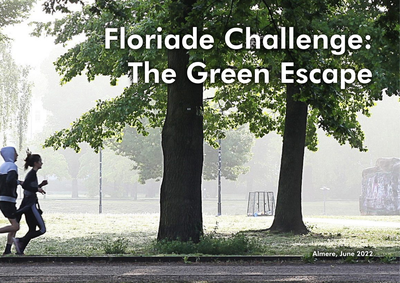Almere is a green city where the greenery extends into the centre through a framework of nature, forests, parks and canals. With this green environment, Almere fulfils an important condition for a liveable city, where it is pleasant to live and work. An important goal for the municipality is to challenge its residents to develop a healthy lifestyle by using that green framework.But what really motivates Almeerders to go outside to exercise, enjoy the surroundings and meet each other? Are there sufficient green meeting or sports facilities nearby? Could the routes that connect the living and working environment with the larger parks or forests be better designed? And can those routes simultaneously contribute to climate adaptation?With the Green Escape Challenge, we invited students and young professionals to work on these assignments together.
DOCUMENT

Green spaces play an important role in urban areas. We study the accessibility of green urban areas by combining open data sets about green with population size data. We develop a mathematical model to define the population density of a green area and calculate the available green space depending on the location. To this end, we do not only consider walking distance to and size of the green area, but also take into account the local population size. Our model quantifies how the available green space depends on the location in the city, such that heavily populated areas have a small amount of green available, even when closely located to a green area.
DOCUMENT

DOCUMENT

Several western governments have implemented environmental policies which increase the cost of air travel. Such policies aim to reduce the impact of air travel on climate change, but at the same time they restrict tourists in their travels. This study examines the extent to which the average tourist's happiness is affected by 'involuntary green travel', defined as reduced CO 2 emission travel imposed by government regulations. This issue was addressed in a study among 588 Dutch citizens who completed a self-report questionnaire containing questions about their happiness. The strongest determinant of tourists' happiness is freedom in choosing a destination. Any policy measure that interferes with tourists' freedom in destination choice will negatively affect tourists' happiness. Six percent of their happiness is at stake and potentially 17% of all holiday trips are affected. The number of tourists involved is possibly much smaller. The best options for governments are to impose taxes on long-haul destinations, which affect only a small share of all tourists, and air routes which can also be travelled by a variety of alternative modes of transport and thus less limiting to destination choice within this market segment.
DOCUMENT
DOCUMENT

This study addresses the complex phenomenon of overtourism in the EU. By focusing on a set of case studies, the study reports on overtourism indicators, discusses management approaches implemented within different destinations and assesses policy responses. It concludes that a common set of indicators cannot be defined because of the complex causes and effects of overtourism. Avoiding overtourism requires custom-made policies in cooperation between destinations' stakeholders and policymakers
DOCUMENT

DOCUMENT

Purpose: This study aimed to determine the motivations of a select group of South Africans in terms of their potential engagement with cultural tourism; more specifically, the study set out to show whether these motivations influence the cultural activities that the tourists want to participate in and whether their interest in specific cultural activities determines their destination choices. Furthermore, the mediating role of activities in the relationship between cultural motivations and destination choice was also assessed. Design/methodology/approach: An online panel survey collected responses from 1,530 potential cultural tourists across South Africa. Hypotheses were tested, using structural equation modelling. Findings: The results show that tourists' motivations for cultural tourism influence their likelihood of participating in specific cultural activities. Cultural tourism is shown to be influenced by more than learning and includes entertainment, relaxation, novelty and escape dimensions. There also seems to be a difference in the activities engaged in by destination type. For example, tourists likely to take part in indigenous cultural tourism activities are more likely to do so at hedonic destinations. Practical implications: This paper contributes to the understanding of cultural tourism activities, aiding destinations in attracting cultural tourists. Destinations need to develop activities that match visitor motivations, increase satisfaction and encourage visitors to return. Originality/value: The paper increases the understanding of cultural tourism in South Africa and underlines the importance of communities in providing distinctive tourism activities. The study also has an important social dimension, highlighting the role of social status in cultural tourism consumption and destination selection.
MULTIFILE
DOCUMENT
